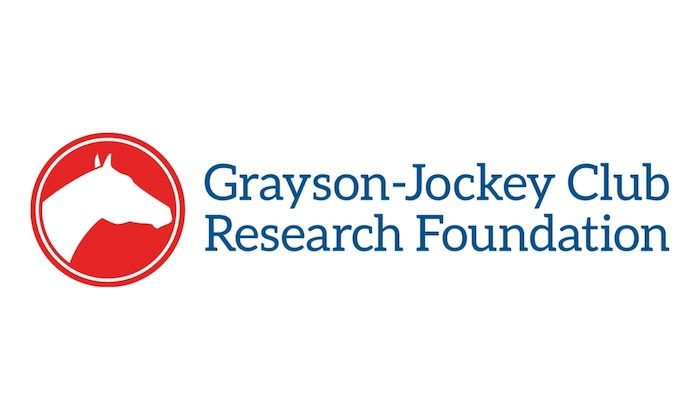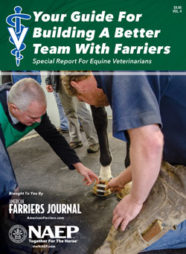Grayson-Jockey Club Research Foundation announced approved funding for 2025 research projects. The board of directors authorized $2.6 million to fund 16 new projects and 10 continuing projects, many of which benefit hoof care.
The Foundation has funded over 450 projects at 48 universities across the globe since 1940. Grant proposals are evaluated with the “goal of identifying scientifically well-founded projects with the greatest impact on both the horse industry and the problem being studied,” says the Foundation’s website.
Research projects with benefits to hoof care include:
Can Smartphone-Based Sensors Provide Reliable and Repeatable Lameness Data
Melissa King, Colorado State University
Inertial measurement units (IMUs) demonstrate promise in collecting stride parameters in equine orthopedic cases and healthy horses. A novel IMU system combines machine learning and computational algorithms to collect timing, distance and biomechanical loading data in human subjects with comparable data to the standard optical motion capture systems. In humans, the smartphone-embedded sensors perform just as well as body-mounted. The study hypothesizes that this smartphone-embedded and body-mounted novel technology provides reliable and repeatable data in lame and non-lame horses.
This non-invasive technology allows equine professionals to detect changes in limb and body movement in real-time. It also gives veterinarians and farriers clues regarding impending injury and the biomechanical state of the horse.
Ex Vivo DFTS Adhesion Model to Evaluate Therapies
Lauren Schnabel, North Carolina State University
After digital flexor tendon injuries, horses can develop bands of scar tissue within the tendon sheath that prevents normal movement of tendons and results in chronic pain and loss of athletic use. The study will explore how adhesions form and test two antiadhesion treatments, enalapril and tissue plasminogen activator (tPA).
Deep and superficial digital flexor tendon injuries prevent up to 50% of horses from returning to previous levels of athletic performance. Adhesions complicate the prognosis further. Results of the study will be immediately applied to horses in a clinical setting and will be used for further studies investing combined treatment options.
Effects of SGLT2i on Triamcinolone-Induced Equine ID
Teresa Burns, Ohio State University
Laminitis associated with endocrine disease is the most common type and is associated with three conditions: Equine Metabolic Syndrome (EMS), equine Cushing’s syndrome and administration of steroid medications. These three conditions differ significantly but all share insulin dysregulation (ID) as a consistent characteristic. Little is known about laminitis after steroid administration. One steroid commonly used to keep equine athletes performing is triamcinolone acetonide (TCA); though, its effects on insulin and glucose metabolism is unclear.
This study will “investigate the effects of TCA injected in the joint for systemic ID in horses with naturally occurring ID and the ability of canagliflozin (a SGLT2 inhibitor used frequently to treat EMS patients) to prevent or decrease ID when given at the time of joint injection,” Burns says.
Its goal is to provide more information about TCA and its role in ID and laminitis as well as the efficacy of a SGLT2i in reducing ID.
Finite Element Analysis of SDFT Microdamage
Sushmitha Durgam, Ohio State University
Cumulative microdamage to tendons is linked to superficial digital flexor tendon (SDFT) injuries. However, the exact changes that occur at the interfascicular matrix (IFM) and collagen-elastin levels are unknown. Building off of previous research, the study aims to develop computational finite element models (FEM) that can predict SDFT mechanical behavior, something that has not been done before for equine tendons and SDFT structures.
Cadaver limbs will be used to establish a foundational analysis and the results used to develop more complex models that account for “the tendons’ tensile and recoil properties, providing a more comprehensive representation of SDFT load-bearing function,” Durgam says.
A non-invasive way to analyze the SDFT structure can help researchers learn more about tendon microdamage and injury development in Thoroughbred racehorses.
Pharmacokinetics and Efficacy of Pregabalin in Horses
Heather Knych, University of California-Davis
Pregabalin and gabapentin are common in equine pain management, though pregabalin is better absorbed through the mouth. This study aims to assess the effects, benefits and pharmacokinetics of pregabalin, using phenylbutazone as a control. Analyzing how the body processes pregabalin and its measurable effects on pain can help better control equine pain while limiting potential side effects.
Characterization of Laminitis Using PET
Dianne McFarlane, University of Florida
The goal of this study is to determine how positron emission tomography (PET) scans can be used “in diagnosis, prognosis and rehabilitation management for horses with laminitis,” McFarlane says.
PET scans will be compared to other radiological markers when characterizing acute, recovery and management of laminitis. These scans may also be able to identify laminitis earlier than current methods, which can aid in a more positive outcome for the horse.
Effects of Inflammatory Cytokines on MSC Homing
John Peroni, University of Georgia
Mesenchymal stem cells (MSCs) turn into bone, cartilage and muscle cells and also help repair damaged tissues. A current lack of understanding in how MSCs home in on an injury makes therapeutic use challenging. This study looks to decipher how MSCs locate an injury after being released into the bloodstream and what bodily signals precipitate it. If MSCs are released during specific stages of repair, scientists can determine the best time to administer MSCs for maximum healing. Clinicians can also inject MSC directly into a wound; however, some wounds are inaccessible via needle.
The distal limb and hoof are common areas where performance-limiting lameness occur. “Treatments could be improved with biological therapeutics, which are recognized for their potent anti-inflammatory effects and promotion of wound healing,” says Peroni.
Racehorse Stride Changes and Workload During Training
Peta Hitchens, University of Melbourne
Detecting early signs of an equine injury can help prevent catastrophic equine or jockey injuries. Past injury risk models classified horses as injured or not at a single point in time, while new technology allows horses to be monitored for internal and external changes over time.
“We previously found a reduction in stride length and speed occurring approximately 6 races prior to injury, as well as more varied speeds linked to injury, and no improvement in stride length linked to horses requiring long periods of rest from racing,” says Hitchens.
This study will allow scientists to record day-to-day changes in addition to race-to-race changes. The goal is to determine if any stride changes occur between racing and training and develop protocols for visualizing workloads, which could help identify horses at higher risk for injury.
Synthetic Proteoglycan Replacement for Osteoarthritis
Kyla Ortved, University of Pennsylvania
This study aims to develop a new class of injectable, cartilage-penetrating compounds made from synthetic polyelectrolytes that replace proteoglycans that are critically lost in osteoarthritis (OA). Joint inflammation following an injury leads to breakdown and loss of proteoglycan, which leads to further cartilage breakdown and is a hallmark of OA. There are currently no effective drugs to halt or reverse OA.
“A key technical challenge is that proteoglycan replacements need to be able to diffuse throughout cartilage to achieve therapeutic benefit. However, any proteoglycan replacement that can easily diffuse into cartilage will also easily diffuse out. To overcome this limitation, our team has developed a fully synthetic proteoglycan replacement based on thermal polymers. As a liquid at room temperature, poly(N-isopropylacrlyamide) (PNiPAm) diffuses rapidly through the joint and into the cartilage. As the polymer reaches body temperature, it undergoes thermal gelation and is “locked in” the cartilage,” says Ortved.
Horses are usually treated with anti-inflammatory drugs and corticosteroids, though they do not reverse joint damage. Newer treatments can decrease inflammation and promote healing, but they do not address the loss of proteoglycan or reverse deteriorating cartilage.
“Here, we seek to establish a new category of joint therapy that can be used in conjunction with anti-inflammatories to provide synthetic support to the ECM and prevent further joint degradation,” says Ortved.
Career Development Awards
The Storm Cat Career Development Award
This award grants $20,000 to an individual considering a career in equine research. This year, Dr. Erica Secor, a Ph.D. student at the Cornell University College of Veterinary Medicine, received the award for her proposed study defining immune cell populations present in naturally occurring equine osteoarthritis and the response to intra-articular therapeutics.
The Elaine and Bertram Klein Career Development Award
This award grants $20,000 to another prospective equine researcher. This year’s recipient is Dr. Shannon Connard of North Carolina State University. The study aims to harness stem cells licensing to enhance tendon healing and further the understanding of intralesional mesenchymal stem cell therapy in treating equine tendon injuries.
To learn more about current research projects, visit the Grayson-Jockey Club Research Foundation website here.







